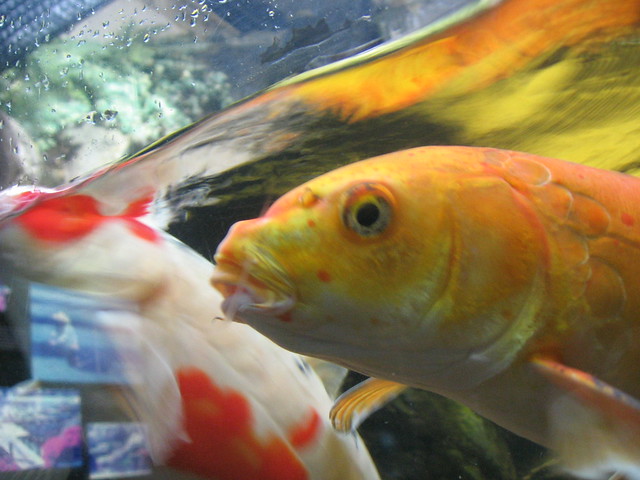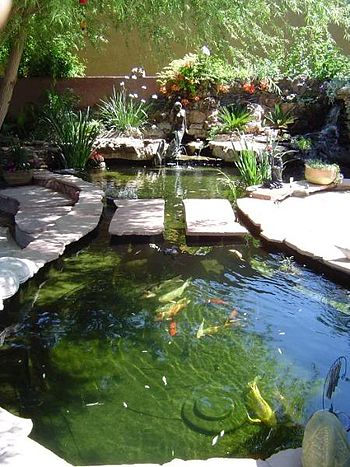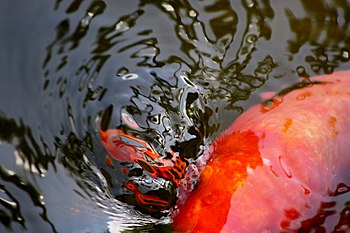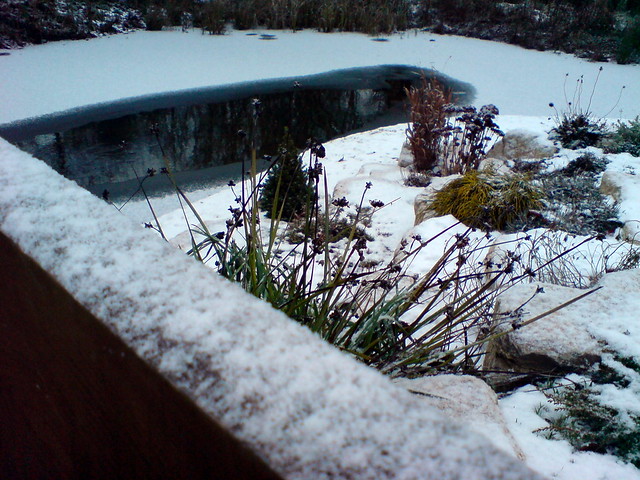 |
| Koi watching the monitor - Photo by The_Gut (cc) |
The common carp was grown for a food fish in China as far back at the fifth century. It has been concluded through scientific study that there is a minimum of two different subspecies of carp. One is from East Asia and another from Eurasia. Through continuous cross-breeding, the various varieties have evolved. Through the study of mitochondrial DNA, it has been learned that Koi are descendants of a variety of hybridized species.
The characteristics that distinguish the Koi are scalation, patterning, and coloration. The primary colors of Koi are black, white, yellow, red, blue and cream. The color combinations are unlimited. Breeders have taken it upon themselves to identify certain color combinations. The most popular of the Koi varieties are the Gasanke which consists of the Taisho Sanshoku, the Showa Sanshoku and the Kohaku varieties.
The crossbreeding has continued. As recently as the 1980's, Ghost Koi was developed in the UK. They are a cross between the wild Koi and the Ogon Koi. Their metallic scales are what distinguish them from other Koi. The dragon carp, which is also known as the Longfin Koi or the Butterfly Koi have long flowing fins which distinguish them from the other varieties. There are those breeders that do not consider the butterfly Koi and ghost Koi to be true Nishikigoi. The development of Koi types continue and the variety of choices increases. There are some who feel that the original Koi types are the only true Koi.
The Various Koi Types
Kohaku: This popular white Koi has red markings on the top of its body. the name Kohaku means red and white. This original Koi developed in the 19th century.
Taisho Sanshoku is also known as Taisho Sanke. In 1914, breeders introduced these types of Koi. They are similar to the Kohaku but have additional black markings. These small black markings are called Sumi. In the United States, they are frequently called Sanke. The kanji can be read as Sanshoku or sanke.
Showa Sanshoku is a black Koi. It has red and white markings. These types of Koi was first shown in 1927 during the Showa empire. The amount of shiroji, white markings, has increased over the years. In the United States, the name has been abbreviated to Showa.
Tancho Koi are distinguished by the single red patch that you see on the head of the Koi. The Koi in this category can be either Tancho Showa, Tancho Sanke or Tancho Goshiki. This Koi was named for the Japanese crane. The crane has a red spot on its head also.
Chagoi is tea-colored Koi. The color covers a wide spectrum of colors from a very pale olive drab green to a copper or bronze hue. Recently some have appeared in shades of orange. These particular Koi types are friendly, docile and very large. Keepers like to keep them in their pond with other Koi varieties as they feel they are a sign of good luck.
Asagi Koi is usually red, yellow or cream below the lateral lines of the fish and on its cheeks. The rest of the fish is a beautiful light blue. The name means pale greenish-blue in Japanese and also spring onion or indigo.
Utsurimono Koi are black and have either white, red or yellow marking. The original is the black and white markings, called the zebra color. The red and white are Hi Utsuri and Shiro Utsuri. Utsuri means to print. The black markings are very similar to ink markings. These types of Koi are genetically the same as Showa but without the white or red pigment.
Bekko is a yellow, white or red skinned Koi that has distinctive black markings. The name translates to "tortoise shell". The white, red and yellow Koi varieties are Shiro Bekko, Aka Bekko and Ki Bekko. Occasionally they are confused with Utsuri.
Shusui translates to "autumn green". The Shusui appeared in 1910. It is a cross between the German mirror carp and the Japanese Asagi. These particular Koi types have one line of large scales that extend from its head to its tail.
Adam Boyle is a Koi Fish enthusiast and enjoys helping others taking care of these wonderful fish. For more great information on Koi Types, visit http://www.koifishinformation.org.
Article Source: EzineArticles
|







